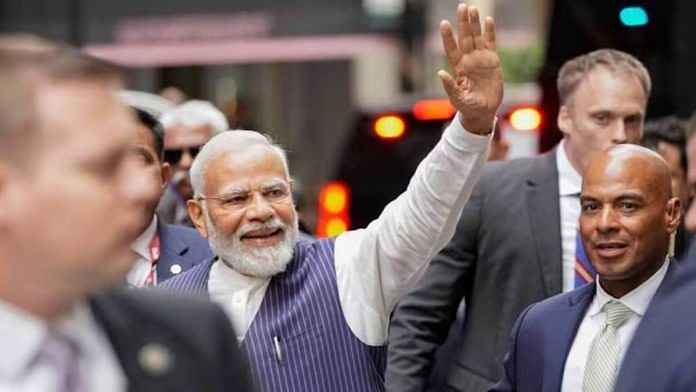New Delhi: Prime Minister Narendra Modi’s first official state visit Tuesday to India’s largest trading partner, the US, began with meetings with the Chief Executive Officers (CEOs) of various US companies and investors, including Tesla founder Elon Musk and hedge-fund manager Ray Dalio.
The visit was preceded by Modi highlighting in a statement before his departure that his discussions with US President Joe Biden and senior US leadership would help “consolidate” bilateral ties between the two nations as well as strengthen multilateral forums such as the G20, the Quad and the Indo-Pacific Economic Framework for Prosperity (IPEF).
It was also reported that ahead of his US visit, the central cabinet had approved the establishment of a $2.7-billion semiconductor testing and packaging unit by US company Micron Technology.
However, in spite of growth in trade, foreign direct investment (FDI) and visa collaboration between India and the US in recent years, a free trade agreement (FTA) — that reduces barriers to imports and exports between nations — remains elusive.
Union Minister of Commerce, Piyush Goyal, had confirmed the same in January this year, stating, “We are looking at much bigger ambitions in our trade with the US” but an “FTA is not on the table”, at a press conference at the end of the India-US Trade Policy Forum meeting held in Washington, said reports.
He had also stated that discussions on a “mini-trade deal” had ended, as the deal was too small to merit any effort by either the US or India.
According to Goyal, the two nations were “focusing on greater market access and ease of doing business”. “You’re looking at, bilaterally, a much larger footprint between the two countries, for trade, investment and business,” he had stated.
Also Read: Not just jet engines & drones — during ongoing US visit, Modi to discuss these key defence deals
‘Much bigger ambitions’
Minister of Labour and Employment Bhupender Yadav had in June 2022 announced that India was negotiating with the US and UK on social security agreements (SSA).
Such pacts would ensure that employers do not have to make double contributions for social security for employees posted in another country. Employees would also be saved from making double payments.
“Ongoing discussions on a social security totalisation agreement” were also acknowledged by Piyush Goyal and US trade representative Katherine Tai in a joint statement at January’s India-US Trade Policy Forum. It also promised to intensify efforts to achieve “early outcomes” on this matter.
Last month, India and the US, along with 12 other countries, reached an agreement on supply chain cooperation under the Indo-Pacific Economic Framework for Prosperity (IPEF). The grouping includes Australia, Brunei, Fiji, India, Indonesia, Japan, South Korea, Malaysia, New Zealand, the Philippines, Singapore, Thailand, Vietnam, and the US.
The member countries have, since the inception of the IPEF, been trying to nail down an international agreement on a wide variety of issues or “pillars”, which include trade, supply chains, clean economy, and fair economy. India is the only partner out of the 14 nations that is not a part of the trade pillar.
ThePrint reached the Ministry of Commerce for a comment via text message on the current status of the SSA with the US, and on whether India could be incentivised to join the trade pillar of the IPEF during Modi’s visit to the US, but had not received a response at the time of publication of this report. The article will be updated if and when a response is received.
FDI, bilateral trade & visas
A variety of sectors between the US and India have seen positive growth over the past few years.
According to the Reserve Bank of India’s annual report, the US was India’s third-largest source of FDI inflows in 2022-23.
Between April 2000 and March 2023, the US accounted for 9 per cent of the total FDI inflows to India, data from the Department for Promotion of Industry and Internal Trade showed. Cumulatively, the total FDI equity inflow from April 2000 to March 2023 stood at $60.1 billion from the US.
Further, the US has, since 2018-19, been India’s biggest trading partner for four out of five fiscal years, according to data from the ministry of commerce. In 2020-21, China was India’s largest trading partner.
Trade between India and the US grew from $87.9 billion in 2018-19 to $128 billion in 2022-23, the data showed.
The growth in trade has been supported by increasing exports of gems and jewellery, among other products, from India to the US.
Vipul Shah, Chairman, Gem & Jewellery Export Promotion Council of India, told ThePrint Wednesday: “The US is the largest consumer market for Indian gems and jewellery. More than 50 per cent of the world’s jewellery is consumed in the US.”
“One of the specific challenges we are facing is to ensure no Russian diamonds enter the US market after sanctions placed on (Russia by the US). We are waiting and watching to see the results of PM Modi’s meeting with President Biden to see what can be done to help the export of gems and jewellery,” Shah added.
In 2022-23, about $12.58 billion worth of pearls, precious or semi-precious stones and imitation jewellery was exported to the US from India. It was India’s largest export to the US in terms of value that year, according to data from the ministry of commerce.
When it comes to US visas, Modi has raised issues — processing delays and backlog — surrounding the coveted H-1B visa (non-immigrant visa that allows US companies to employ foreign workers in specialty occupations) and L-1 visa (pertaining to intra-company transfer) with every US administration since he became prime minister in 2014.
The US had in fiscal 2022 allotted 72.6 per cent of its H-1B visas to Indians, according to a report in The Times of India.
(Edited by Nida Fatima Siddiqui)
Also Read: India-US ties reaching a turning point. But General Electric won’t ever get us complete tech






